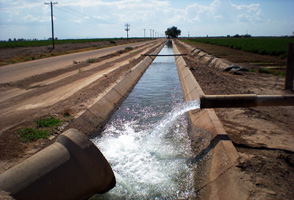Farmers in arid central Arizona have always faced a formidable climatic challenge. The region around Phoenix receives a scant fraction of the annual rainfall needed to irrigate traditional crops like alfalfa and cotton, and summertime high temperatures make it the hottest metropolitan area in the United States. Nevertheless, infrastructure improvements and policy have made both booming urban development and exceptional agricultural yields possible in the Phoenix area over the last few decades. These developments, however, have also buffered farmers from directly experiencing signals of climate change.

This may now be changing. The severe drought conditions that have affected the West since the turn of the century have called into question the long-term reliability of the Colorado River system, which has underwritten regional growth. Some irrigation district managers are now reexamining expectations about how much water they can deliver to agricultural water users. For instance, one irrigation district manager said, “We have to plan for the future. If we know we’re going to have a dry year and I know the reservoirs are really low, if we think there’s going to be a shortage then we’ve got to do something, to either get more wells in or let the farmers know. We’re probably their best source of information.”
Monitoring future supply
Understanding how farmers and irrigation district managers use climate information has been a priority in research supported by the National Oceanic and Atmospheric Administration (NOAA) at Arizona State University, in collaboration with the University of Arizona Cooperative Extension Service. Irrigation district managers cannot rely solely on local forecasts for their decision making: some monitor stream gauges located on Colorado River tributaries more than a thousand stream-miles away. Many managers keep track of how policy decisions about reservoir management, energy production, and inter-sector water allocation may affect the quantity, quality, and cost of the water they access. An irrigation district manager explains, “We use NOAA, I use the ski reports a lot from Colorado because you can get all the averages and see what it’s done in the past week so you know if you’re gaining or losing snow.” In turn, these managers try to pass on this information to users, including farmers, whether through official channels or during informal meetings on ditch banks and in coffee shops.
Additional adaptation strategies
Improved information is only one part of the adaptation puzzle. Irrigation district managers are now thinking creatively about how to ensure that infrastructure is maintained to allow flexible adjustments between groundwater and surface water sources. During a water shortage, limitations on groundwater pumping capacity can be just as challenging as getting enough water for crops. Depending on the ownership and control of groundwater wells within a district, managers can strategize by running only the most efficient wells, ensuring that pumps in the same location aren’t running at the same time, and by making substitutions between local water allotments to keep operational costs even. Some are also engaging directly with water suppliers and utilities outside the region to ensure reliable and affordable access in the future. For the first time, in 2015, some central Arizona irrigation districts are volunteering to forgo a portion of their water allotment in the reservoir behind Hoover Dam as part of a multi-state experiment in extreme drought operations. Others have forgone groundwater pumping through water banking agreements.
Urbanization, competition for water and land, and volatility in agricultural policy, as well as energy and commodity prices, challenge efforts to further innovate in water practices. While farmers hope to continue contributing to the rural economy, they worry that their long-term viability will depend as much on how state and city managers value their presence and resource needs as it does on their own capacities to proactively respond to rapidly changing water supplies.
[iframe src=”//player.vimeo.com/video/86935576″ width=”500″ height=”281″]
Working with the farming community
Farmers in this region come from a community shaped by generations of coping with extreme heat, and they are experiencing an extended drought. They are also literally losing ground to urban development. Many are apt to focus on what is familiar and near, depending upon strategies they have used in the past. For example, a third-generation farmer in the area explained, “The standing water table depth when my dad bought this farm was about 20 feet, and the last time we measured it was 25 feet to the water, so the depth to the water is very shallow. Right off the bat the thing that it tells you is that we are not pumping fossil water, it absolutely is rechargeable.” Farmers’ knowledge and experience comprise rich, site-specific detail, on a different scale and often with contrary implications compared to observations made by policymakers and researchers. Effective policy dialogs need to respectfully bridge these differences.
The past success of efforts to secure and diversify water sources may have created new, more obscure, vulnerabilities and interdependencies. Like generations before them, farmers today are independent entrepreneurs. Nevertheless, the outcomes of individuals’ decisions have never been more contingent upon each other: from maintaining local irrigation ditches and district wells, to balancing demands from major interstate water and energy generation infrastructure, farmers are not only needing to collaborate with each other, but also with others representing urban, energy, and ecological interests in Arizona and in neighboring states. It will take a continuing effort by all interested parties in central Arizona to learn to accommodate uncertainties in water supply and tradeoffs in water use decisions into the future.
Source: U.S. Climate Resilience Toolkit
Story Credit:
Skaidra Smith-Heisters and Hallie Eakin, Arizona State University.
Banner Image Credit:
Hallie Eakin, Arizona State University

